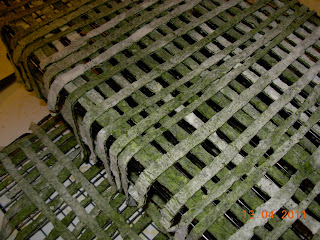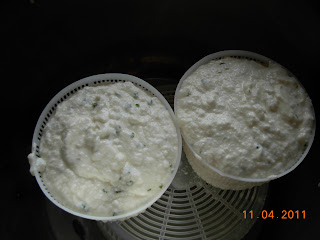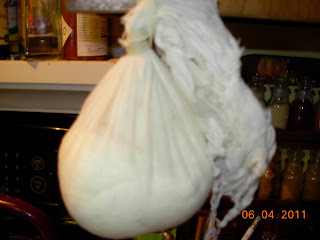My hero, Tamra Hartley-Smith, gave me a recipe for spinach noodles. Something similar is available online. As the recipe could be made with frozen spinach, I decided to make some.
For the recipe, you need 10 ounces of frozen spinach, 2 eggs, 1 teaspoon of salt and 2 cups of flour.
Because the recipe did not include garlic or onions or pepper, I decided to add some of each.
Let the dough sit, covered, for thirty minutes. After it sits, divide the dough into two sections. Use a rolling pin to roll the each of the dough sections until they're 1/4 inch thick. Roll up the dough as if you are making a jelly roll, then slice the dough into 1/4 inch wide sections. Unroll the slices until they're flat and let them dry for at least an hour.
Cook the noodles in a pot of salted boiling water for 15 to 20 minutes. Drain the noodles and serve. Delicious!
With the New Year, I decided to start a project that will chronicle our efforts to eat naturally for a year.
Wednesday, April 20, 2011
Monday, April 18, 2011
Making Fromage Blanc with Raw Milk
Making Fromage Blanc with raw milk is something I enjoy because raw milk is so easy to work.
To make Fromage Blanc with whole milk, the beginning of the process is much the same. Pour a gallon of milk into a pot large enough to hold it. Dilute four drops of rennet in 1/4 cup of water and set it aside. Heat the milk to 75 degrees F, stirring constantly, then remove the pot from the heat. Add 1/4 teaspoon of culture to the pot and let it sit for 4 minutes. Stir the milk and culture 20 times, then add the rennet and water mixture. Cover the pot and set it aside.
By the next day, the curds begin to set up, separating from the edge of the pot.
Place a colander in the sink and line it with cheese cloth.
Pour the curds into the colander.
Gather up the ends of the cheese cloth and close them with the curds inside, squeezing the whey from the curds.
Put the curds back into the pot and add onion powder, garlic powder and chives.
Stir the curds until all the ingredients are blended.
Place the basket from a salad spinner upside down in a pot, and place the molds on top of the salad spinner basket. It is not necessary to line the molds with cheese cloth.
Ladle the curds into the molds. You will be able to transfer all of the curds into the molds in a few minutes without having to wait as you would with whole milk.
Once all the curds are in the molds, cover the pot and set it aside. By the next day, the curds will have drained completely. Remove the curds from the molds and enjoy!
To make Fromage Blanc with whole milk, the beginning of the process is much the same. Pour a gallon of milk into a pot large enough to hold it. Dilute four drops of rennet in 1/4 cup of water and set it aside. Heat the milk to 75 degrees F, stirring constantly, then remove the pot from the heat. Add 1/4 teaspoon of culture to the pot and let it sit for 4 minutes. Stir the milk and culture 20 times, then add the rennet and water mixture. Cover the pot and set it aside.
By the next day, the curds begin to set up, separating from the edge of the pot.
Place a colander in the sink and line it with cheese cloth.
Pour the curds into the colander.
Gather up the ends of the cheese cloth and close them with the curds inside, squeezing the whey from the curds.
Put the curds back into the pot and add onion powder, garlic powder and chives.
Stir the curds until all the ingredients are blended.
Place the basket from a salad spinner upside down in a pot, and place the molds on top of the salad spinner basket. It is not necessary to line the molds with cheese cloth.
Ladle the curds into the molds. You will be able to transfer all of the curds into the molds in a few minutes without having to wait as you would with whole milk.
Once all the curds are in the molds, cover the pot and set it aside. By the next day, the curds will have drained completely. Remove the curds from the molds and enjoy!
Sunday, April 17, 2011
Making Mayonnaise
I made mayonnaise again--the first time since being in Penn Yan. I used the recipe from Root Cellaring by Mike and Nancy Bubel. The recipe is something that is surprisingly simple to make. If you have a blender and some basic ingredients, you can have a batch in a few minutes.
To make mayonnaise, you need two egg yolks, 1/2 teaspoon of dry mustard, 1 tablespoon of honey, 2 tablespoons of vinegar, 1 tablespoon of lemon juice and a cup of salad oil.
Add all but the oil to the blender and blend it together until they are smooth. (I had to switch to a more conventional blender as I had not anticipated what an issue the absence of a lid would be). Once they're blended, slowly add the oil. The ingredients will take on the texture of mayonnaise.
It is wonderful...
To make mayonnaise, you need two egg yolks, 1/2 teaspoon of dry mustard, 1 tablespoon of honey, 2 tablespoons of vinegar, 1 tablespoon of lemon juice and a cup of salad oil.
Add all but the oil to the blender and blend it together until they are smooth. (I had to switch to a more conventional blender as I had not anticipated what an issue the absence of a lid would be). Once they're blended, slowly add the oil. The ingredients will take on the texture of mayonnaise.
It is wonderful...
Saturday, April 9, 2011
Making Mozzarella
Mozzarella is a good cheese that can be made in one day--thus can be eaten sooner rather than later. While it can be made with whole milk, I find that raw milk works best.
To make this cheese, you will need one gallon of raw milk, 1 1/2 teaspoon of citric acid, 1/4 teaspoon of lipase powder dissolved in 1/4 cup of water and 1/4 teaspoon of rennet dissolved in 1/4 cup of water. Peripheries include a pot large enough to hold the milk, a mixing spoon, a thermometer, cheese cloth, a slotted spoon, a colander, a bowl, heat-proof gloves, a second bowl filled with cold water (salt added to the water is optional), and string or rubber bands.
Heat the milk, stirring constantly, to 55 degrees F and add the lipase and citric acid. Continue heating the milk. When the milk reaches 88 degree F, add the rennet. You will notice that the milk will begin to form curds.
Remove the pot from the heat when the temperature reaches about 100 degree F (do not let it rise above 105 degrees F). Scoop out the curds with a slotted spoon and put them (or it, depending on the milk you use) into a colander.
Heat the whey remaining in the pot to 175 degrees F, then return the curds to the pot. Don heat-proof gloves and knead and stretch the curd (in my case) becomes pliable. Remove the curd from the pot and cool it in a bowl filled with cold water.
When the curd is cool, wrap it in cheese cloth and allow it to drain.
After the cheese has finished draining, remove it from the cheese cloth and eat!
As always, many thanks to Barbara Skapa of Echo Ridge Farmstead Cheese.
To make this cheese, you will need one gallon of raw milk, 1 1/2 teaspoon of citric acid, 1/4 teaspoon of lipase powder dissolved in 1/4 cup of water and 1/4 teaspoon of rennet dissolved in 1/4 cup of water. Peripheries include a pot large enough to hold the milk, a mixing spoon, a thermometer, cheese cloth, a slotted spoon, a colander, a bowl, heat-proof gloves, a second bowl filled with cold water (salt added to the water is optional), and string or rubber bands.
Heat the milk, stirring constantly, to 55 degrees F and add the lipase and citric acid. Continue heating the milk. When the milk reaches 88 degree F, add the rennet. You will notice that the milk will begin to form curds.
Remove the pot from the heat when the temperature reaches about 100 degree F (do not let it rise above 105 degrees F). Scoop out the curds with a slotted spoon and put them (or it, depending on the milk you use) into a colander.
Heat the whey remaining in the pot to 175 degrees F, then return the curds to the pot. Don heat-proof gloves and knead and stretch the curd (in my case) becomes pliable. Remove the curd from the pot and cool it in a bowl filled with cold water.
When the curd is cool, wrap it in cheese cloth and allow it to drain.
After the cheese has finished draining, remove it from the cheese cloth and eat!
As always, many thanks to Barbara Skapa of Echo Ridge Farmstead Cheese.
Monday, April 4, 2011
Making Fromage Blanc
Fromage Blanc is one of my favorite cheeses to make because it is relatively simple to make and it tastes delicious. It can be made with both raw milk or whole milk. The textures are different as well as the taste.
To make Fromage Blanc with whole milk, you will need a gallon of whole milk and a pot large enough to hold the milk, cheese culture for soft cheese (MA4011/4002), liquid rennet and 1/4 cup of water. A digital thermometer is helpful, but an accurate analog one works just as well.
Add four drops of rennet to 1/4 cup of water. Heat the milk to 75 degrees F, then remove it from the heat. Add 1/4 teaspoon of culture and sprinkle it into the milk. Set the timer for four minutes, then stir the milk twenty times. Add the diluted rennet, cover the pot and set it aside.
Over time, the curd will separate from the whey.
For the next step, you will need garlic powder, onion powder, chives, cheese molds, and fine cheese cloth. The inside of a salad spinner works well as a platform on which the molds can sit and drain.
When the curds have hardened and the whey is clear, drain as much of you can of the whey from the curds. Add chives, garlic powder and onion powder. Stir it thoroughly.
Line the cheese molds with cheese cloth--the finer the better.
Set the basket from the salad spinner upside down in a pot and set the cheese molds upon it. Ladle the curds into the cheese molds until both are full.
Ladle the curds into the molds until they are full.
Cover the pot and set it aside. Check the pot throughout the day. As the whey drains from the molds, continue adding more curds until you have transferred all the curds from the cooking pot into the molds. When you are finished, you will see the whey in the bottom of the pot.
Cover the molds and turn them upside down so that the cheese can drain from the top down. Setting them on a baking rack that spans a pot works well. After the curds have drained, remove the cheese from the mold and set them on plates or the container of your choice.
Fromage Blanc is wonderful on crackers, bread, or bagels, mixed with pasta to make a white sauce, in soups and stews. Eat and enjoy!
Note: Many thanks to Barbara Skapa, the Cheese-Maker (http://www.mainecheeseguild.org/map/echoridge.html).
To make Fromage Blanc with whole milk, you will need a gallon of whole milk and a pot large enough to hold the milk, cheese culture for soft cheese (MA4011/4002), liquid rennet and 1/4 cup of water. A digital thermometer is helpful, but an accurate analog one works just as well.
Add four drops of rennet to 1/4 cup of water. Heat the milk to 75 degrees F, then remove it from the heat. Add 1/4 teaspoon of culture and sprinkle it into the milk. Set the timer for four minutes, then stir the milk twenty times. Add the diluted rennet, cover the pot and set it aside.
Over time, the curd will separate from the whey.
For the next step, you will need garlic powder, onion powder, chives, cheese molds, and fine cheese cloth. The inside of a salad spinner works well as a platform on which the molds can sit and drain.
When the curds have hardened and the whey is clear, drain as much of you can of the whey from the curds. Add chives, garlic powder and onion powder. Stir it thoroughly.
Line the cheese molds with cheese cloth--the finer the better.
Set the basket from the salad spinner upside down in a pot and set the cheese molds upon it. Ladle the curds into the cheese molds until both are full.
Ladle the curds into the molds until they are full.
Cover the pot and set it aside. Check the pot throughout the day. As the whey drains from the molds, continue adding more curds until you have transferred all the curds from the cooking pot into the molds. When you are finished, you will see the whey in the bottom of the pot.
Cover the molds and turn them upside down so that the cheese can drain from the top down. Setting them on a baking rack that spans a pot works well. After the curds have drained, remove the cheese from the mold and set them on plates or the container of your choice.
Fromage Blanc is wonderful on crackers, bread, or bagels, mixed with pasta to make a white sauce, in soups and stews. Eat and enjoy!
Note: Many thanks to Barbara Skapa, the Cheese-Maker (http://www.mainecheeseguild.org/map/echoridge.html).
Subscribe to:
Comments (Atom)






























